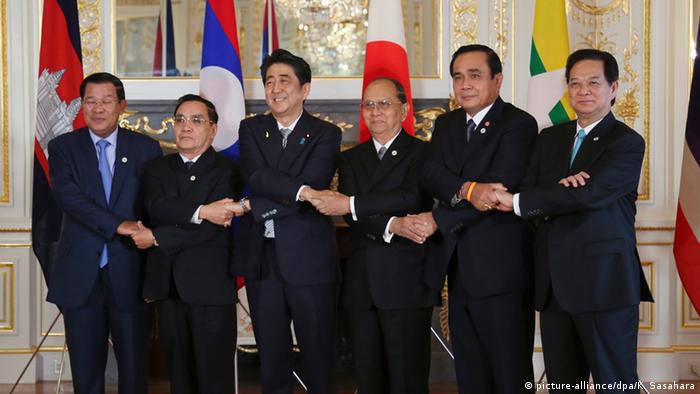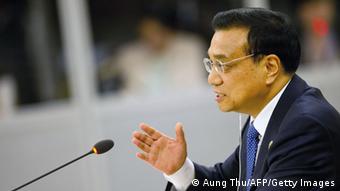“湄公河五國”將獲日本資金援助
日本週六承諾向柬埔寨、老撾、緬甸、泰國以及越南提供總額為61億美元的資金援助。日本希望此舉能夠促進本國的基礎設施出口,並相應擴大在該地區的影響力。中國也同樣在東南亞地區尋求擴大影響。

日本每年都會與"湄公河五國"舉行一次峰會,今年已經進入了第七個年頭。
DW.COM
(德國之聲中文網)日本首相安倍晉三週六(7月4日)與上述五國首腦舉行會晤。這五個位於湄公河下游流域的國家當前經濟都在高速增長期。安倍晉三說:"在今後三年,日本將以正式發展援助的形式提供約7500億日元(合61億美元)的援助。"他還指出,湄公河流域對基礎設施建設存在著巨大的需求,也是日本的重點經營地區之一。
日本每年都會與"湄公河五國"舉行一次峰會,今年已經進入了第七個年頭。安倍晉三強調,日本將致力於湄公河地區的基礎設施發展,"既追求數量也追求質量;湄公河地區與日本是共同發展的合作夥伴。"
不過,安倍在講話中並沒有明確這7500億日元的援助承諾究竟是全新發放的款項、還是也包括早前已經落實的財政援助項目。
日本與中國爭奪地區影響力
安倍晉三近期正在大力向海外推銷日本建設的高速公路、鐵路以及電力設施。這也是日本尋求提振經濟、擴大海外影響力的重要措施。

李克強:"中國和東盟十國正步入起點更高、內涵更廣、合作更深的'鑽石十年'。"
而財力見長、意欲進一步提升外交影響力的中國,也更加促使日本加快步伐爭奪地區影響力。就在去年11月,中國總理李克強在緬甸舉行的東盟峰會上指出,中國和東盟十國"正步入起點更高、內涵更廣、合作更深的'鑽石十年'。"今年3月,中國外長王毅則表示,中國與東盟雙邊貿易額今年將力爭達到五千億美元,而2020年的目標則是一萬億美元。此外,中國近期還組建了亞投行,與日本主導的亞洲開發銀行構成競爭關係。
Japan said on Saturday it would extend around $6 billion in development aid to Mekong region countries, as China prepares to launch a new institutional lender seen as encroaching on the regional clout of Tokyo and ally Washington.
Japan Inc. Goes Deeper Into Southeast Asia
Cheap Labor Attracts Factories to China's Sphere; A Master Plan in Laos
Sept. 28, 2014 9:19 p.m. ET

Workers in Savannakhet, Laos, make children's bath balls for Bandai, a Japanese maker of toys and videogames. Warangkana Chomchuen/The Wall Street Journal
SAVANNAKHET, Laos—Japanese companies are turning to Southeast Asia's frontier markets in search of cheaper labor, stepping into territory that until now has been firmly in China's sphere of influence.
Take Savannakhet, a town on the banks of the Mekong river where eight Japanese companies have recently started operations. They include camera-lens producerNikon Corp. 7731.TO +0.65% and a Toyota 7203.TO +0.39% group auto-component maker.
Laos, an impoverished country of seven million people run by a small Communist elite, is a close ally of Beijing. China is a top aid donor and by far the largest investor in the country, with interests in mining, hydropower and agriculture.
Japan wants to change this equation. The industrial estate just outside Savannakhet is part of a Japan-funded master plan in Laos that includes a bridge over the Mekong to Thailand and the upgrading of a highway to the border with Vietnam.
"This country has a possibility to be a transportation hub for our company," said Hiroshi Yamamoto, a Laos-based manager at a Japanese firm which produces camera parts for Nikon at the industrial estate.
It is an example of how Japan is leveraging aid and investment in Southeast Asia to counterbalance China's growing clout in the region. Vietnam received $1.7 billion in aid from Japan in 2012, the most it gave to any country and up two-thirds from the previous year. Japan is ramping up aid to Cambodia, Myanmar and Laos—traditional allies of China—albeit from a low base.
The push comes at a time when disputes over territory and wartime history have worsened ties between Japan and China and deepened divisions in the region.
"Clearly, hedging against China is now a major consideration in Japanese aid," said David Potter, a professor at Japan's Nanzan University who is an expert on Japan's official overseas disbursements.
A senior Japanese trade official acknowledged that Tokyo views aid as a way of breaking China's pre-eminence in poor nations like Cambodia and Laos. "We are hoping to see indigenous industries grow in these countries, so they can stand on their own, and become less dependent on China," the official said.
Japan's push is mimicking its strategy in Thailand in the 1980s and 90s, when Japan helped finance a big buildup of Thailand's infrastructure. Japanese companies from auto makers to electronics firms now account for over two-thirds of foreign investment in Thailand.
That effort was driven by economic concerns, but also worked to bind the countries closer together: Thailand has remained an ally of Japan as tensions have mounted in the region around China's increasing territorial assertiveness.
Now, the frontier markets of Laos and Cambodia offer Japanese companies a cheaper alternative to both Thailand and China itself. Average salaries in Thailand have risen by around 40% since a minimum-wage increase two years ago, and worker shortages are common.
Few Japanese companies say they will leave Thailand, a major export hub, but they are increasingly looking to move labor-intensive businesses to neighboring countries.
"We were looking for a way to reduce production costs, but we also needed to locate near Thailand," said Toshiko Watanabe, a spokeswoman for automobile-component maker DensoCorp. 6902.TO -0.42% , which last year opened a production facility in Cambodia.
There are limits to the trend, and size matters: Thailand benefited massively along with Indonesia, another big consumer market, when Japan hastily shifted investment away from China after anti-Japanese riots there in 2012. Japanese firms invested around $10 billion in Thailand last year, a record, according to Japan's Finance Ministry.
Vietnam, a large nation of 92 million people that—like Japan—is involved in territorial disputes with China, attracted almost $3 billion in investment, up by a half from 2012. Meanwhile, smaller countries like Cambodia and Laos are likely to remain appendages to Thailand's supply chain.
Japanese firms are eager to make inroads in Myanmar, which has been looking to reduce its dependence on China. Tokyo has provided funds for the development of an industrial zone south of Yangon, but the country's huge infrastructure hurdles limit investment plans.
Japanese investment in Cambodia last year, for instance, was $127 million, up three-quarters on 2012, but still relatively small. Chinese firms invested 10 times more in Cambodia than Japanese companies between 2005 and 2012 and over four times more in Laos, according to the Association of Southeast Asian Nations.
The push isn't problem-free. Some Japanese firms complain that workers in Laos and Cambodia, predominately agrarian economies, often leave factory jobs at harvest time. Others work to earn money to go back to school.
"The biggest challenges in Cambodia are recruitment and employee retention," said Yasuo Komine, a spokesman for Minebea Co. 6479.TO +3.57% Ltd., a Japanese maker of motors and ball bearings. The company set up a factory in Cambodia recently, where over 6,000 workers complete simple tasks like gluing components onto motors.
China, too, is digging in. Last year, Chinese President Xi Jinping announced plans to launch a new Asian infrastructure bank, a potential rival for the Japan-dominated Asian Development Bank, which so far has coordinated efforts to improve infrastructure in Southeast Asia. China is also involved in plans for high-speed rail links to connect Yunnan province with Laos and Thailand.
Still, in Laos, government officials say they are excited about the uptick in interest. Pledged Japanese investment in the country jumped to $406 million in 2013 from $27.5 million in 2012, and exceeded Japanese government aid for the first time, according to Motoyoshi Suzuki, a Japanese economic official who is advising the Laotian government.
Mr. Suzuki's data include investment from Japanese companies' subsidiaries in Thailand and other countries. They are higher than estimates by Japan's Finance Ministry, which comprise only realized outlays from firms' Japan headquarters.
"The cost in Laos is a third of that in China," said Hoshi Hiroyuki, managing director at a Japanese-Lao joint venture that makes children's toys at the Savannakhet industrial estate.
Toyota Boshoku Corp. 3116.TO -1.64% recently began making seat covers in Savannakhet, which it sends to Toyota Motor Corp.'s main auto-production facilities in Thailand.
"Suppliers for cars and small- and medium-size businesses are studying the Laos option very seriously," said Bounthavy Sisouphanthong, vice minister at Laos' Planning and Investment ministry.
Write to Warangkana Chomchuen at warangkana.chomchuen@wsj.com and Mitsuru Obe at mitsuru.obe@wsj.com



沒有留言:
張貼留言